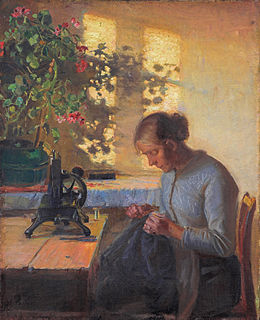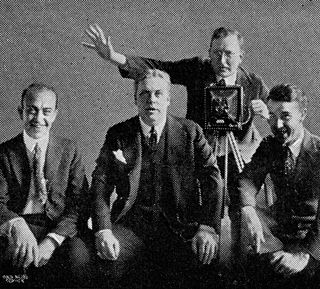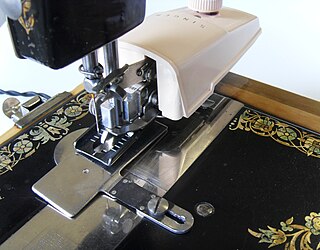
Singer Corporation is an American manufacturer of consumer sewing machines, first established as I. M. Singer & Co. in 1851 by Isaac M. Singer with New York lawyer Edward C. Clark. Best known for its sewing machines, it was renamed Singer Manufacturing Company in 1865, then the Singer Company in 1963. It is based in La Vergne, Tennessee, near Nashville. Its first large factory for mass production was built in 1863 in Elizabeth, New Jersey.

A sewing machine is a machine used to sew fabric and materials together with thread. Sewing machines were invented during the first Industrial Revolution to decrease the amount of manual sewing work performed in clothing companies. Since the invention of the first sewing machine, generally considered to have been the work of Englishman Thomas Saint in 1790, the sewing machine has greatly improved the efficiency and productivity of the clothing industry.

Sewing is the craft of fastening or attaching objects using stitches made with a sewing needle and thread. Sewing is one of the oldest of the textile arts, arising in the Paleolithic era. Before the invention of spinning yarn or weaving fabric, archaeologists believe Stone Age people across Europe and Asia sewed fur and leather clothing using bone, antler or ivory sewing-needles and "thread" made of various animal body parts including sinew, catgut, and veins.

The Brass Era is an American term for the early period of automotive manufacturing, named for the prominent brass fittings used during this time for such things as lights and radiators. It is generally considered to encompass 1896 through 1915, a time when these vehicles were often referred to as horseless carriages.

Brother Industries, Ltd. is a Japanese multinational electronics and electrical equipment company headquartered in Nagoya, Japan. Its products include printers, multifunction printers, desktop computers, consumer and industrial sewing machines, large machine tools, label printers, typewriters, fax machines, and other computer-related electronics. Brother distributes its products both under its own name and under OEM agreements with other companies.

The Peerless Quartet was an American vocal group that recorded in the early years of the twentieth century. They formed to record for Columbia Records, where they were credited as the Columbia Quartet or Columbia Male Quartet. From about 1907, when they began to record for record labels other than Columbia, they were more widely known as the Peerless Quartet.

The Merrow Sewing Machine Company, best known for inventing the overlock sewing machine, is a manufacturer of sewing machines. After the explosion of his gunpowder mill in 1837, in 1838 J.M. Merrow built a knitting mill on the same site. The company developed crocheting machines for its own use and by 1887 evolved to design, build and market sewing machines exclusively. During its early decades it was organized as a partnership under various names: established in 1838 as Joseph M. Merrow & Sons by J. Makens Merrow, then Pitkin, Merrow, & Co., renamed Merrow Manufacturing Co. in 1857, then Merrow and Millard in 1863, J.B. Merrow and Sons in 1870, and incorporated as The Merrow Manufacturing Company in 1893. Originally all of its manufacturing was done at facilities in Merrow, Connecticut, and then in Hartford, Connecticut, after 1894. The company is currently based in Fall River, Massachusetts.
Bernina International AG is a privately owned international manufacturer of sewing and embroidery systems. The company was founded in Steckborn, Switzerland, by a Swiss inventor Fritz Gegauf. The company develops, manufactures, and sells goods and services for the textile market, primarily household sewing-related products in the fields of embroidery, quilting, home textiles, garment sewing, and crafting. The origins of the company lie in the invention of the hemstitch sewing machine, invented in 1893 by a Swiss inventor and entrepreneur Karl Friedrich Gegauf. Currently, the company's products include sewing machines, embroidery machines, serger/overlocker machines, and computer software for embroidery design.
Heirloom sewing is a collection of needlework techniques that arose in the last quarter of the 20th century that imitates fine French hand sewing of the period 1890-1920 using a sewing machine and manufactured trims.

The White Sewing Machine Company was a sewing machine company founded in 1858 in Templeton, Massachusetts, by Thomas H. White and based in Cleveland, Ohio, since 1866. Founded as the White Manufacturing Company it took the White Sewing Machine Company name when it was incorporated in 1876.
Janome is a Japanese company that produces sewing machines, with manufacturing plants in Japan, Taiwan and Thailand.

Bradbury Motor Cycles was a British motorcycle manufacturer based in Oldham, England and established in 1902. Originally involved in the manufacture of machine tools, sewing machines and cycles, their first motorcycles were bicycles with clip-on Minerva engines. The Bradbury factory went on to develop and produce a range of single-cylinder motorcycle, V-twins and horizontally opposed twins. The 1912 Bradbury motorcycles were one of the earliest with variable gearing. Although the factory survived the First World War it closed in 1924.
William L. Grout (1833–1908) was an U. S. industrialist and pioneer manufacturer of sewing machines and automobiles.
The Singer Model 27 and later model 127 were a series of lockstitch sewing machines produced by the Singer Manufacturing Company from the 1880s to the 1960s.. They were Singer's first sewing machines to make use of "vibrating shuttle" technology. Millions were produced. They are all steel and cast iron, and were built before the advent of planned obsolescence, and so they were designed to be repaired rather than replaced. Consequently many remain today, some in collections and others still in service. In company literature they were called "the woman's faithful friend the world over".
A vibrating shuttle is a bobbin driver design used in home lockstitch sewing machines during the second half of the 19th century and the first half of the 20th century. It supplanted earlier transverse shuttle designs, but was itself supplanted by rotating shuttle designs.
A zigzag stitch is variant geometry of the lockstitch. It is a back-and-forth stitch used where a straight stitch will not suffice, such as in reinforcing buttonholes, in stitching stretchable fabrics, and in temporarily joining two work pieces edge-to-edge.

The White Sewing Machine was the first sewing machine from the White Sewing Machine Company. It used a vibrating shuttle bobbin driver design; for that reason, and to differentiate it from the later White models that used a rotary hook design instead, it came to be known as the "White Vibrating Shuttle" or "White VS". In 1879 it cost USD50 to US$125 depending on which table or cabinet it was to be mounted in. The White VS continued in production, with improvements, until the early 1900s.

A buttonholer is an attachment for a sewing machine which automates the side-to-side and forwards-and-backwards motions involved in sewing a buttonhole.
The Jones Sewing Machine Company was a British manufacturer of sewing machines founded in 1860 by William Jones and Thomas Chadwick under the name Chadwick and Jones that later become known as the Jones Sewing Machine Company.










